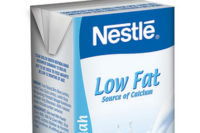By Nestle
Optimal dissolution of powders is critical for providing consumers with a smooth and appealing beverage that ensures adequate delivery and uptake of important nutrients. Unfortunately, incomplete dissolution, with concomitant formation of lumps, can arise during the development of new, nutritious powdered food products. The mechanisms underlying the problem are complex and have, hitherto, been poorly understood.
In the frame of the collaboration between the Nestlé Research Center (NRC), Lausanne, Switzerland and the ESPCI Paris Tech (École Supérieure de Physique et de Chimie Industrielles) Paris, France, scientists have discovered a novel physical mechanism by which water wets and then dissolves soluble solids.
The findings are a major advance in our understanding of the mechanisms underlying the dissolution of soluble powders. The results of the study have been published in the journal Physical Review Letters.
Successful dissolution of a powder is dependent on the physical and chemical nature of both the substrate and the solvent. In the current study, the scientists examined the contact between a droplet of water and a thin layer of a long chain sugar, coated on a smooth surface. The various sugars used in the study were non-crystalline “amorphous” sugars that lack an organized molecular structure and as such, can easily undergo a change of state.
Two synchronized video cameras simultaneously measured the angle of contact, as well as the velocity, of the water droplet as it spread over the surface of the sugar layer. The absorption and diffusion of the water in the sugarcoating were also measured by analyzing the color changes of reflected light. This study shows for the first time that the manner in which a water droplet spreads over a non-crystalline substrate, such as maltodextrin, strongly depends on the amount of water absorbed and on the softness of the substrate in the immediate vicinity of the water droplet.
The current work is an important step towards mastering the dissolution of powdered food products. The quantitative theory which was developed will allow the conditions of dissolution of different soluble substrates to be predicted with greater accuracy. As a consequence, this will allow the development of a wider range of products that are not only nutritious but more pleasurable for the consumer.
Article Reference
Julien Dupas, Emilie Verneuil, Maxime Van Landeghem, Bruno Bresson, Laurent Forny, Marco Ramaioli, François Lequeux, Laurence Talini. Physical Review Letters 2014. Glass transition accelerates the spreading of polar solvents on a soluble polymer.



